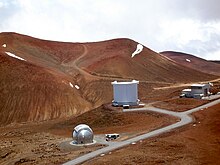James Clerk Maxwell Telescope
The James Clerk Maxwell Telescope (JCMT) is a radio telescope for wavelengths in the sub-millimeter range with a 15 meter receiving antenna in the Mauna Kea Observatory in Hawaii . It is the world's largest radio telescope that specializes in this wavelength range. There are a number of instruments for different frequency ranges. It is used to study the solar system , interstellar matter and distant galaxies .
The JCMT was created through cooperation between Great Britain , Canada and the Netherlands and went into operation in 1987. It was named in honor of the Scottish physicist James Clerk Maxwell . It is now controlled by the East Asian Observatory . In conjunction with the Caltech Submillimeter Observatory , a submillimeter interferometer was created for the first time . This successful experiment laid the foundation for the submillimeter array and the Atacama Large Millimeter Array interferometer.
It is part of the Event Horizon Telescope (EHT) project and was one of the telescopes of the worldwide network of eight radio telescopes, with which in 2017 (published in April 2019) the first direct images of a black hole (the supermassive black hole in M87 ) were obtained.
Web links
- JCMT Homepage (English)
credentials
- ↑ WS Holland et al., SCUBA: a common-user submillimetre camera operating on the James Clerk Maxwell Telescope, Monthly Notices of the Royal Astronomical Society: Letters Volume 303 Issue 4, Pages 659 - 672, 2002 doi : 10.1046 / j.1365 -8711.1999.02111.x
Coordinates: 19 ° 49'22.3 " N , 155 ° 28'38.4" W.

